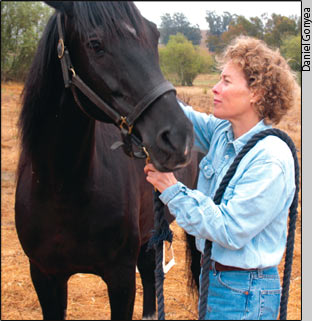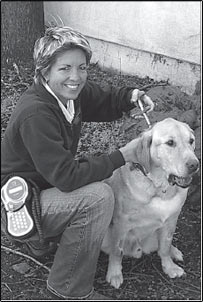April 2006
Straighten Up and Gallop Right!
Veterinary chiropractic can help heal injuries, ease pain
by Kerry Bleskan

Taco (short for La Taco Bella) seemed to be a healthy two-year-old when one day she simply couldn’t stand up. Her vet gave the fawn-colored Chihuahua a cortisone shot to reduce some inflammation near her hip joint but said he couldn’t do much more. The nearby vet school might be able to help, but tests would be very expensive. Faced with few options, Taco’s family, the Loys, learned how to take care of their very sick girl, feeding her by syringe and expressing her bladder.
“She couldn’t even bark,” Mesha Loy said. “She was basically a vegetable, but we didn’t want to just give up on her.” Six weeks after that emergency trip to the vet, someone told Loy about veterinary chiropractic, so she decided to take Taco to Calistoga chiropractor Maryanne Kraft.
The results were amazing, Loy said. After just one visit, Taco could stand. Shortly after the second visit, Taco was continent again, and was soon truly mobile. Loy’s husband called her at work. “You’re not going to believe this,” he shouted into the phone. “She’s running in the yard. She’s running in the yard!”
Sublux what?
Chiropractic care is a physical adjustment of the spine and/or joints meant to keep them properly aligned. It is based on the principle that the bones of the spine and joints should be in a specific alignment. When that alignment is disrupted (a “subluxation”), healthy body function can be disrupted in turn. “Subluxations affect the nervous system, local muscles, joints and even distant organs, glands and body functions,” according to the American Veterinary Chiropractic Association (AVCA).
The term chiropractic was coined in 1895 from the Greek words “cheir” (hand) and “praktos” (done): “done by hand.” Back then chiropractors seeking respect for their new profession worked on animals primarily “to demonstrate that the adjustment had more than a placebo effect, as had been charged by the medical community,” according to Daniel Kamen’s The Well Adjusted Dog .The profession has long since come into its own (although legislative quirks in some states forbid chiropractors to work on animals).
 Chiropractic
is used to help animals with a wide range of ailments, including injuries,
muscle spasms, nerve problems, and pain. Since treatment does not involve
drugs or surgery, it appeals to natural-medicine types, but can also
be combined with conventional health care. “I receive referrals
from vets as well as people finding me on their own,” Kraft said. “More
owners and vets are becoming receptive to this specialized form of
noninvasive treatment.”
Chiropractic
is used to help animals with a wide range of ailments, including injuries,
muscle spasms, nerve problems, and pain. Since treatment does not involve
drugs or surgery, it appeals to natural-medicine types, but can also
be combined with conventional health care. “I receive referrals
from vets as well as people finding me on their own,” Kraft said. “More
owners and vets are becoming receptive to this specialized form of
noninvasive treatment.”
Uh, I think my pet frog is subluxed
“Everyone is a good candidate for chiropractic care,” says Kraft . “Our spines house our central nervous system, which controls every function of the body. It is important to have that system working at its optimal level.”
“Pets, service and other working animals, and those involved in agility and the show ring can all benefit from chiropractic support,” said Kelly MacKay, a chiropractor who does “house and barn calls” throughout Sonoma and Marin counties. She is certified through the American Veterinary Chiropractic Association, which offers its two-year course only to chiropractors and veterinarians.
“I treat all kinds of animals for all kinds of reasons,” MacKay said. “About half of my patients are horses, the other half, dogs and cats. A few months ago I went to see a show goat, and occasionally a rat or guinea pig comes my way.”
The “all kinds of reasons” include emergencies and longtime ailments. “Chiropractic care can assist in complete recovery from acute injuries such as those caused by falling, rough play, agility mishaps. In these cases, seeing the chiropractor sooner rather than later is best.”
MacKay said that chronic, painful conditions such as arthritis also can be eased by chiropractic care. “If the problem is of a progressive, degenerative nature, a complete resolution may not be possible. However, a greater level of comfort, some improvement in function, and a slowing of the degenerative process is a realistic expectation.”
Is it time get tuned up again, already?
If you and your vet decide to try chiropractic for your pet, expect treatment to start with the first appointment. “During the animal’s first visit I basically just take a history of the patient from the owner and start treating,” Kraft said. The technique Kraft uses, Veterinary Orthopedic Manipulation (VOM), employs a tool called an accelerometer to identify the areas of the spine that need attention. She also incorporates energy work called Animal Talk (“It allows me to ask the animal questions [and receive] muscle responses”) and light therapy meant to enhance the body’s own healing ability. “The combination of these three modalities is very unique,” she said.
The VOM technique is different from the manual adjustment taught by the AVCA, defined as a “short lever, high velocity controlled thrust by hand or instrument.”
The number and frequency of chiropractic visits will depend on your animal’s injury. Taco went regularly for nearly a year; her visits are now made as needed. Her canine “sister” Gracie, a Corgi who injured her hip blazing around after Taco, goes in for treatment a few times a year, at times when she seems irritable.
Three years after her injury, Taco is not 100% and probably never will be, but she continues to improve. “She still walks a little drunkenly,” Loy said. “She can’t jump up on things, but can get over the door step. She eats, barks, and runs around. As far as I’m concerned, Dr. Kraft saved her life.”
Does it hurt?
Veterinary chiropractor Julie Kaufman stresses that animal adjustments are less intense than those often used on people; she compares the force used in an animal adjustment to that used on an infant.
Many animals visibly enjoy their adjustment, say chiropractors and clients. “Taco gives Dr. Kraft dirty looks the whole time” she’s being adjusted, Mesha Loy said, but uncharacteristically “doesn’t snap, snarl, or try to back away” either. “She loves the heat therapy. It loosens everything up so all those muscles and joints can just slide back into place. That’s when she just gives in.”
Loy thinks that Taco’s treatments not only improve her mobility, but also help her deal better with her health issues. When she has nerve spasms, for example, she often falls off the furniture, but is seldom hurt. “I think with the ‘body talk,’ Dr. Kraft taught Taco how to fall.”
Taco’s speedy recovery isn’t unique, according to the AVCA, which says that many animals will show immediate improvement after their first adjustment. Kraft agrees. “The great thing about chiropractic with animals is that you see results very quickly, usually within one to four treatments.”
It’s evident that veterinary chiropractors adore their work. MacKay calls her practice “the most rewarding, joyous work I can imagine.”
“I love treating animals because they are great patients,” Kraft said. “They are very powerful healers themselves, so it is important to me that they are taken care of so they are more equipped to take care of us.”

